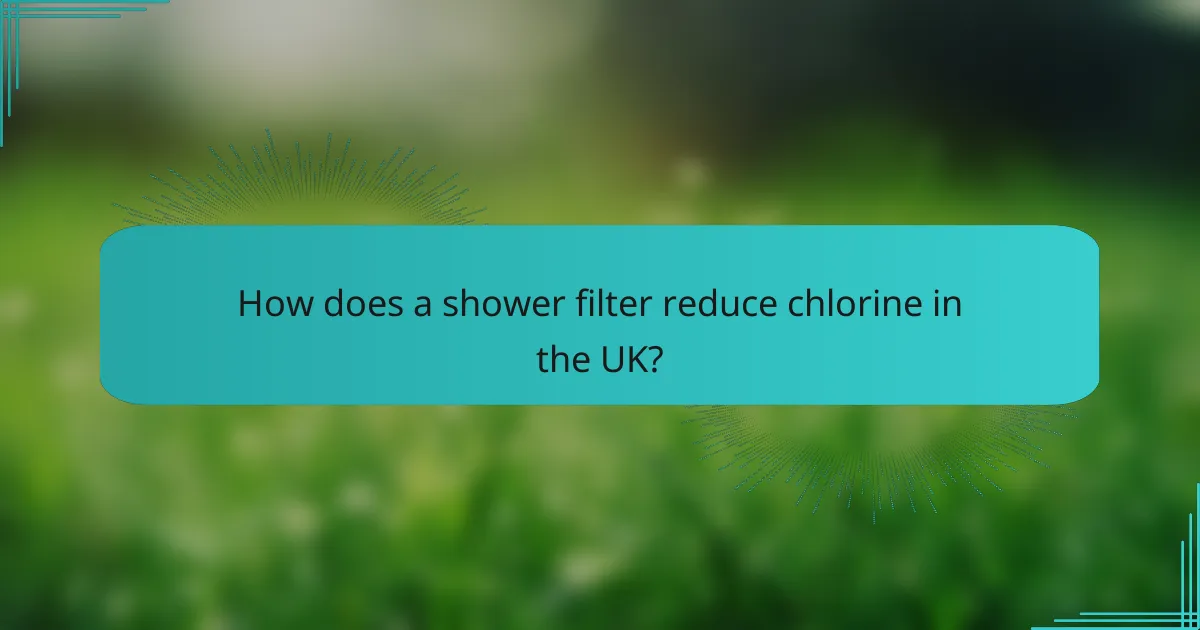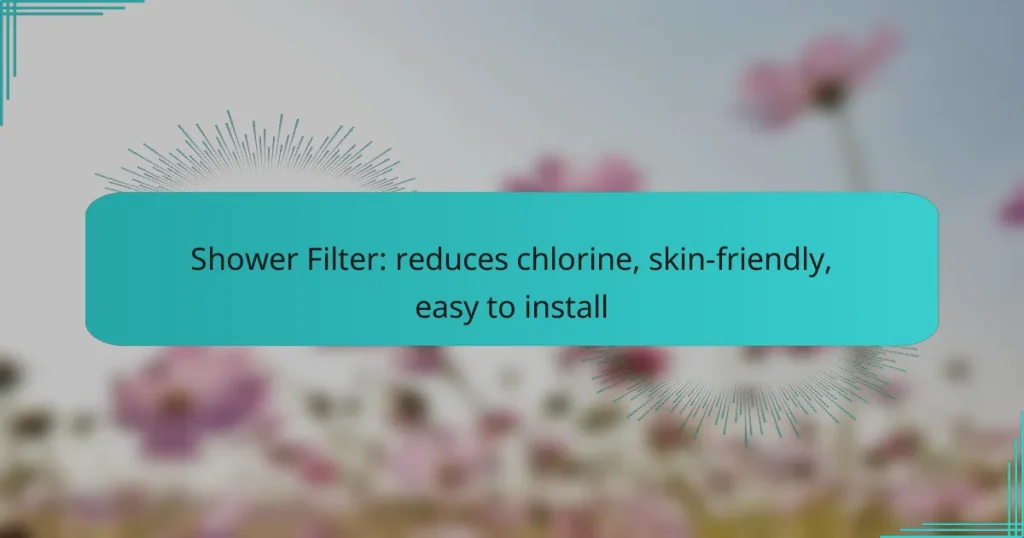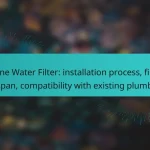A shower filter is an effective solution for reducing chlorine levels in your water, enhancing both skin and hair health. By utilizing advanced filtration technologies, these filters neutralize chlorine before it comes into contact with your skin, resulting in a gentler and more enjoyable shower experience. Additionally, they are easy to install, making them a convenient choice for anyone looking to improve their water quality.

How does a shower filter reduce chlorine in the UK?
A shower filter reduces chlorine in the UK by using various filtration technologies that capture and neutralize chlorine before it reaches your skin. This process not only improves water quality but also makes it gentler on the skin and hair, promoting a healthier shower experience.
Activated carbon filtration
Activated carbon filtration is a common method used in shower filters to reduce chlorine. The porous nature of activated carbon allows it to adsorb chlorine molecules effectively, removing them from the water supply. This type of filtration can also eliminate other impurities, enhancing the overall quality of your shower water.
When selecting a filter with activated carbon, look for models that specify their chlorine reduction capabilities, as effectiveness can vary. Many filters can reduce chlorine levels significantly, often by over 90%.
KDF media technology
KDF (Kinetic Degradation Fluxion) media technology is another effective method for chlorine removal in shower filters. This technology uses a copper-zinc alloy to create a redox reaction that transforms chlorine into a harmless substance. KDF is particularly effective in high-temperature water, making it suitable for showers.
Filters utilizing KDF media can also help control scale buildup and bacteria growth, providing additional benefits beyond chlorine reduction. Look for filters that combine KDF with other filtration methods for optimal performance.
Multi-stage filtration systems
Multi-stage filtration systems combine various filtration technologies, such as activated carbon and KDF, to maximize chlorine reduction and improve water quality. These systems often include additional stages that target specific contaminants, providing a comprehensive solution for cleaner shower water.
When considering a multi-stage filter, check for certifications that demonstrate its effectiveness in reducing chlorine and other harmful substances. These filters can be more expensive but often deliver superior results and longer-lasting performance.

What are the benefits of using a shower filter?
Using a shower filter provides several benefits, including reducing chlorine levels in water, promoting skin health, and being easy to install. These advantages contribute to a more pleasant and healthier showering experience.
Improved skin hydration
A shower filter can significantly enhance skin hydration by removing harsh chemicals like chlorine that strip moisture from the skin. When chlorine is filtered out, the water retains more of its natural moisture, leading to softer and more supple skin.
Many users report that their skin feels less dry and tight after showering with filtered water. This improvement can be particularly beneficial for individuals with naturally dry skin or conditions like eczema.
Reduction in skin irritation
Shower filters help reduce skin irritation by eliminating chlorine and other irritants commonly found in tap water. These substances can cause redness, itching, and discomfort, especially for sensitive skin types.
By using a shower filter, individuals may experience fewer breakouts and less inflammation, making it a valuable addition for those prone to skin issues. Regular use can lead to a noticeable decrease in irritation over time.
Enhanced hair health
Filtered water can improve hair health by removing chlorine and other damaging chemicals that can lead to dryness and brittleness. When these substances are filtered out, hair retains more moisture and natural oils, resulting in shinier and healthier locks.
Users often find that their hair is easier to manage and style after using a shower filter. Additionally, the reduction in chemical exposure can help prevent color fading for those with dyed hair.

How to choose the right shower filter?
Choosing the right shower filter involves considering the filter type, flow rate, and installation requirements. Each factor plays a crucial role in ensuring effective chlorine reduction and skin-friendliness.
Filter type and technology
Shower filters come in various types, including activated carbon, KDF (Kinetic Degradation Fluxion), and vitamin C filters. Activated carbon filters are effective at reducing chlorine and other chemicals, while KDF filters can also eliminate heavy metals and bacteria. Vitamin C filters neutralize chlorine and chloramine, making them a good choice for sensitive skin.
When selecting a filter, consider the technology that best suits your needs. For example, if you have hard water, a KDF filter may be more beneficial due to its ability to address mineral buildup.
Flow rate considerations
The flow rate of a shower filter is essential for maintaining water pressure while ensuring adequate filtration. Most shower filters have flow rates ranging from 1.5 to 2.5 gallons per minute (GPM). A higher flow rate may provide a more satisfying shower experience, but it could compromise the filter’s effectiveness.
Check the specifications of the filter to ensure it meets your desired flow rate without sacrificing performance. A good rule of thumb is to choose a filter that maintains a flow rate close to your existing showerhead.
Installation requirements
Installing a shower filter is generally straightforward and requires minimal tools. Most filters are designed to fit standard showerheads and come with clear instructions. Typically, you will need an adjustable wrench and possibly plumber’s tape for a secure fit.
Before purchasing, verify the compatibility of the filter with your shower setup. Some filters may require additional adapters for specific types of showerheads. Ensure you follow the manufacturer’s guidelines to avoid leaks and ensure optimal performance.

What are the installation steps for a shower filter?
Installing a shower filter involves a few straightforward steps that can significantly enhance your shower experience by reducing chlorine and other impurities. With basic tools and a little time, you can easily set up a filter that is skin-friendly and improves water quality.
Step 1: Gather necessary tools
Before starting the installation, ensure you have the right tools on hand. Typically, you will need an adjustable wrench, plumber’s tape, and possibly a cloth to protect the fixtures. Having these tools ready will streamline the process and help avoid delays.
Check the shower filter’s manual for any specific requirements. Some filters may come with additional components that require specific tools, so it’s wise to review the instructions beforehand.
Step 2: Remove existing showerhead
To install the shower filter, first, you need to detach the existing showerhead. Use the adjustable wrench to loosen the connection between the shower arm and the showerhead. Be careful not to apply too much force, as this could damage the plumbing.
Once loosened, gently twist and remove the showerhead by hand. If there is any old plumber’s tape on the threads, clean it off to ensure a good seal when you install the new filter.
Step 3: Install the shower filter
With the old showerhead removed, you can now install the shower filter. Begin by wrapping plumber’s tape around the threads of the shower arm to prevent leaks. Then, attach the shower filter according to the manufacturer’s instructions, ensuring it is securely fastened.
Finally, reattach the showerhead to the filter. Tighten it gently with the wrench, but avoid overtightening, which could cause damage. Once everything is connected, turn on the water to check for leaks and ensure the filter is functioning properly.

What are the maintenance tips for shower filters?
To maintain shower filters effectively, focus on regular filter replacement, cleaning the showerhead, and inspecting for leaks. These steps ensure optimal performance and longevity, providing cleaner water for your skin.
Regular filter replacement
Replacing your shower filter regularly is crucial for maintaining its effectiveness in reducing chlorine and other impurities. Most filters need replacement every six months to a year, depending on usage and water quality.
Check the manufacturer’s guidelines for specific recommendations. Keeping a calendar reminder can help you stay on track with replacements, ensuring your filter continues to provide skin-friendly water.
Cleaning the showerhead
Cleaning the showerhead is essential to prevent mineral buildup that can affect water flow and filtration efficiency. A simple solution of vinegar and water can effectively dissolve deposits; soak the showerhead in this mixture for about an hour.
After soaking, scrub the showerhead with a soft brush to remove any remaining residue. Regular cleaning every few months can significantly enhance your shower experience and prolong the life of your filter.
Inspecting for leaks
Regularly inspecting your shower filter for leaks is vital to ensure it operates efficiently. Look for any signs of water escaping around the connections or filter housing, as this can indicate a need for tightening or replacement.
Perform a visual check every few weeks and listen for unusual sounds during use. Addressing leaks promptly can prevent water waste and maintain the filter’s performance.

How do shower filters compare to whole-house filtration systems?
Shower filters and whole-house filtration systems serve different purposes in water treatment. While shower filters focus on reducing contaminants like chlorine in the water used for bathing, whole-house systems filter water at the entry point, affecting all taps and appliances.
Cost-effectiveness
Shower filters are generally more affordable than whole-house filtration systems. A typical shower filter can cost between $30 and $100, while whole-house systems often range from several hundred to thousands of dollars, depending on the complexity and brand.
For those on a budget or renting a home, shower filters provide a cost-effective solution to improve water quality without the high upfront investment of a whole-house system.
Installation complexity
Shower filters are designed for easy installation, often requiring no special tools and taking only a few minutes to set up. Most models simply attach to the existing showerhead or pipe.
In contrast, whole-house filtration systems usually involve more complex installation, often requiring professional assistance to ensure proper integration with plumbing and compliance with local codes.
Targeted filtration
Shower filters specifically target contaminants like chlorine, heavy metals, and sediment, making them ideal for improving skin and hair health during showers. They effectively reduce the harshness of water, which can lead to dryness and irritation.
Whole-house systems provide broader filtration, addressing a wider range of contaminants throughout the entire home. However, if your primary concern is the water quality during showers, a dedicated shower filter may be the more effective choice.


